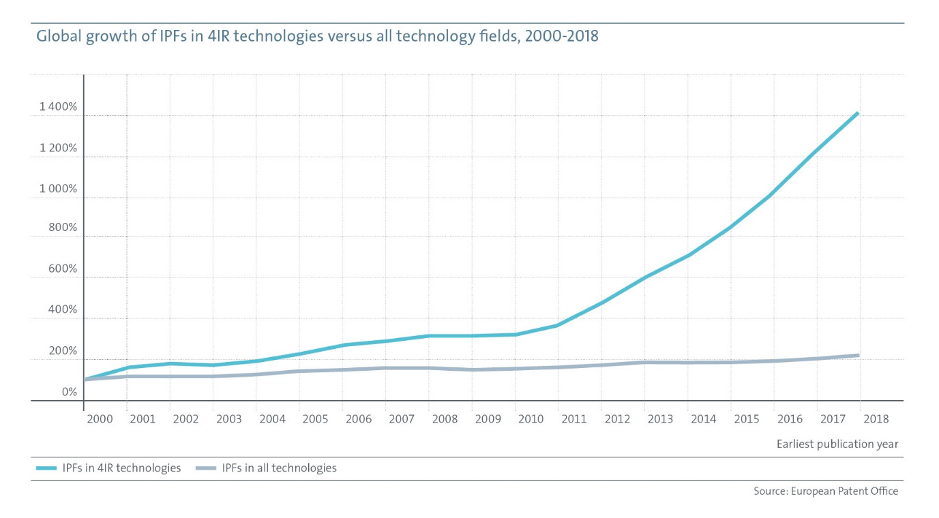“The US remains the world leader in Fourth Industrial Revolution technology, despite the fast growth of 4IR innovation in Korea and China.”
 The European Patent Office (EPO) issued a press release and 75-page study on December 10, titled “Patents and the Fourth Industrial Revolution – the global technology trends enabling the data-driven economy,” which examined global trends in innovation in fourth industrial revolution (4IR) technologies. As used in the study, 4IR denotes “the full integration of information and communication technologies (ICT) in the context of manufacturing and application areas such as personal, home, vehicle, enterprise and infrastructure,” and it marks a “radical step towards a fully data-driven economy.” The study examined international patent families (IPFs), i.e., inventions for which patent applications have been filed in two or more patent offices, related to 4IR worldwide between 2000 and 2018. The study revealed that, between 2010 and 2018, global patent filings for 4IR technologies, including smart connected objects, Internet of Things, Big Data, 5G, and Artificial Intelligence (AI), grew at an average annual rate of almost 20%, which is nearly five times faster than the average of all technology fields.
The European Patent Office (EPO) issued a press release and 75-page study on December 10, titled “Patents and the Fourth Industrial Revolution – the global technology trends enabling the data-driven economy,” which examined global trends in innovation in fourth industrial revolution (4IR) technologies. As used in the study, 4IR denotes “the full integration of information and communication technologies (ICT) in the context of manufacturing and application areas such as personal, home, vehicle, enterprise and infrastructure,” and it marks a “radical step towards a fully data-driven economy.” The study examined international patent families (IPFs), i.e., inventions for which patent applications have been filed in two or more patent offices, related to 4IR worldwide between 2000 and 2018. The study revealed that, between 2010 and 2018, global patent filings for 4IR technologies, including smart connected objects, Internet of Things, Big Data, 5G, and Artificial Intelligence (AI), grew at an average annual rate of almost 20%, which is nearly five times faster than the average of all technology fields.
4IR Technologies
4IR inventions were divided into three main sectors, i.e., “core technologies”, “enabling technologies” and “application domains”, each of which are subdivided into several technology fields. Core technologies correspond to the basic building blocks upon which the technologies of 4IR are built, including IT hardware, software and connectivity. Enabling technologies build upon and complement the core technologies and include eight technology fields including data management, user interfaces, core AI, geo-positioning, power supply, data security, safety, and three-dimensional support systems. Application domains encompass the final applications of 4IR technologies in various parts of the economy and include the fields of consumer goods, home, vehicles, services, industrial, infrastructure, healthcare and agriculture. Since 2010, the number of IPFs has grown at rate of 23.0% in core technologies, 20.3% in enabling technologies and 19.0% in application domains. The study noted that there was significant overlap among the three main sectors, with about 60% of the IPFs for 4IR technologies relating to more than one sector, and 11.8% of relevant to all three sectors.

Top Global Applicants in 4IR Technologies
The study analyzed the main applicants in 4IR technologies at the EPO in the period 2010-2018 and noted that the top 25 applicants together accounted for 37.9% of all IPFs. The top applicants included nine Japanese companies, seven US companies and five European companies. Samsung was the clear leader in 4IR technologies with over 12,000 IPFs between 2000 and 2018, followed by the Asian companies Sony (6,401) and LG (6,290) and the U.S. company Qualcomm (6,223). Also ranking in the list of top 10 4IR applicants were Microsoft (5th), Huawei (6th), Intel (7th), Nokia (8th), Apple (9th), and Ericsson (10th). Samsung (KR) was the clear leader with respect to each of the 4IR technology sectors. LG (KR) and Qualcomm (US) ranked 2nd and 3rd in core technologies, Sony (JP) and Qualcomm (US) ranked 2nd and 3rd in enabling technologies, and LG (KR) and Sony (JP) ranked 2nd and 3rd in application domains.

Global Geography of 4IR Innovation
The EPO report also analyzed the geographic origin of 4IR innovation, as identified by the locations of the inventors of international patent families (IPFs) for 4IR technologies and noted that the US was “by far the most innovative world region in 4IR technologies, with about one third of all the IPFs” between 2000 and 2018. Overall, the study showed that innovation in 4IR technologies was largely dominated by the US (32%), Europe (20%) and Japan (19%), which together accounted for more than 70% of all IPFs. The study stated that “[t]he US remains the world leader in 4IR technology, despite the fast growth of 4IR innovation in Korea and China. Europe is losing ground to other global 4IR innovation [centers], despite the remarkable performance of small countries such as Sweden and Switzerland.”

With respect to the 4IR sectors, the study indicates that U.S. leadership in 4IR innovation is evenly spread across all categories of 4IR technologies. However, the United States “has developed particularly strong advantages in certain fields, including core software technology (e.g., operating systems, databases, cloud computing), core artificial intelligence (e.g., neural networks, deep learning, rule-based systems), 3D systems and the healthcare application domain.” According to the study, Europe and Japan had a stronger specialization in enabling technologies and application domains, rather than core technologies. For example, Japan’s has an outstanding performance in enabling technology fields such as data management and user interfaces, while European tend to be more specialized in safety, 3D systems and geo-positioning.

![[IPWatchdog Logo]](https://ipwatchdog.com/wp-content/themes/IPWatchdog%20-%202023/assets/images/temp/logo-small@2x.png)

![[Advertisement]](https://ipwatchdog.com/wp-content/uploads/2024/04/Patent-Litigation-Masters-2024-sidebar-early-bird-ends-Apr-21-last-chance-700x500-1.jpg)

![[Advertisement]](https://ipwatchdog.com/wp-content/uploads/2021/12/WEBINAR-336-x-280-px.png)
![[Advertisement]](https://ipwatchdog.com/wp-content/uploads/2021/12/2021-Patent-Practice-on-Demand-recorded-Feb-2021-336-x-280.jpg)
![[Advertisement]](https://ipwatchdog.com/wp-content/uploads/2021/12/Ad-4-The-Invent-Patent-System™.png)







Join the Discussion
No comments yet.